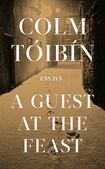
In the penultimate essay of A Guest at the Feast, Colm Tóibín quotes Seamus Heaney on the Irish writer John McGahern: “[His] imagination is ruminant. It chews the cud of the past, digests and redigests it, interrogates it for its meaning, savours it for its bittersweet recurrence.” It is a striking quote, not just for its pinpoint reading of McGahern’s style, but for the fact that the same can be said of Tóibín’s writing. The Wexford author’s abiding interest in history, both personal and political, can be seen across his oeuvre.
From his fictionalised biographies of Henry James and Thomas Mann, to the crossover of public and private worlds in his second novel The Heather Blazing, the delineation of female lives in Brooklyn and Nora Webster, the reimagining of Greek mythology from marginalised perspectives in House of Names and his 2019 play Pale Sister, there is the sense always of a writer looking to tell the story behind the story, to disturb the parts in the dark.
A Guest at the Feast showcases to remarkable effect this same impulse in Tóibín’s non-fiction. Featuring 11 essays, published in 1995-2020, the collection shows the author, at various stages of life, circling back on the same concerns from different angles: religion, homosexuality, illness, literature, art, morality, the small business of what it means to be alive. These recurring preoccupations give great depth to the essays. The collection as a whole is a lesson in how the right words in the right order can get to the truth of a matter.
The current Laureate for Irish Fiction, Tóibín has won the Costa Novel Award, the IMPAC Award and has been shortlisted for the Booker Prize three times. The essays in A Guest at the Feast are by turns erudite, forensic, moving, wry and appeared first in the Dublin Review, the New Yorker, and most frequently, the London Review of Books. Fans of Tóibín may remember the titular second essay, which was published as a standalone by Penguin in 2011. The longest in the collection, it is an ode to childhood, to Enniscorthy, his parents, the communal way of life in small towns, that also offers in glimpses a portrait of the artist as a young man: “I lived in a permanent state of dreamy distance from things.”
READ MORE
Tóibín’s personal circumstances give him a unique outlook on many of the public matters discussed in the collection. A Brush with the Law, published in The Dublin Review in 2007, is a fascinating look at the workings of the Supreme Court in 1980s Ireland, which begins when Tóibín is sent to cover, as editor of Magill magazine, David Norris’s constitutional challenge to Ireland’s laws against homosexuality. Tóibín applies his formidable intellect to documenting the twists and turns of the case. We see the rigour of thought and understanding of nuance that made him such a good journalist, inflected with the humanity of personal experience: “To be gay in a repressive society is to have every moment of your life clouded by what is forbidden and what must be secretive.”
The breadth of the collection is impressive: a snapshot of Irish society over decades; Buenos Aires, in the wake of thousands of ‘disappeared’ people; Covid-era Venice, a city without tourists. Split into three parts, the middle section comprises essays on the Catholic Church, which I confess to have prejudged as potentially dated and uninteresting. Incorrect. The deft characterisations of Popes Francis and Benedict will surprise readers only aware of their public personas. A startlingly honest and visceral piece on the Ferns Report child abuse scandal, meanwhile, sees Tóibín use his personal knowledge of certain priests as a way into trying to understand how they came to do such terrible things.
Tóibín’s knack for timing, whether by chance or design, is notable as the collection progresses: he went to St Peter’s school as a boarder, he travelled to Buenos Aires in 1985, he befriended the controversial writer Francis Stuart, John McGahern, the composer Frederick May, who he meets in the Stag’s Head. These artists and their work are memorialised in these essays, with Tóibín unafraid of revising his views over the years. People and public affairs can take a long time to understand. Tóibín has the benefit and wisdom of hindsight.
The wonderful opening essay on his testicular cancer shows his stoicism in the face of illness, yet gives a searing breakdown on the realities of being sick, in pain, alone, unable for company, for reading, for food, even for water: “The effect of the drug darkened the mind or filled it with something hard and severe and relentless. It was like pain or a sort of anguish, but those words don’t really cover it.” Written with brutal clarity and flashes of humour, it encapsulates Tóibín as a whole, a master of light and shade.














